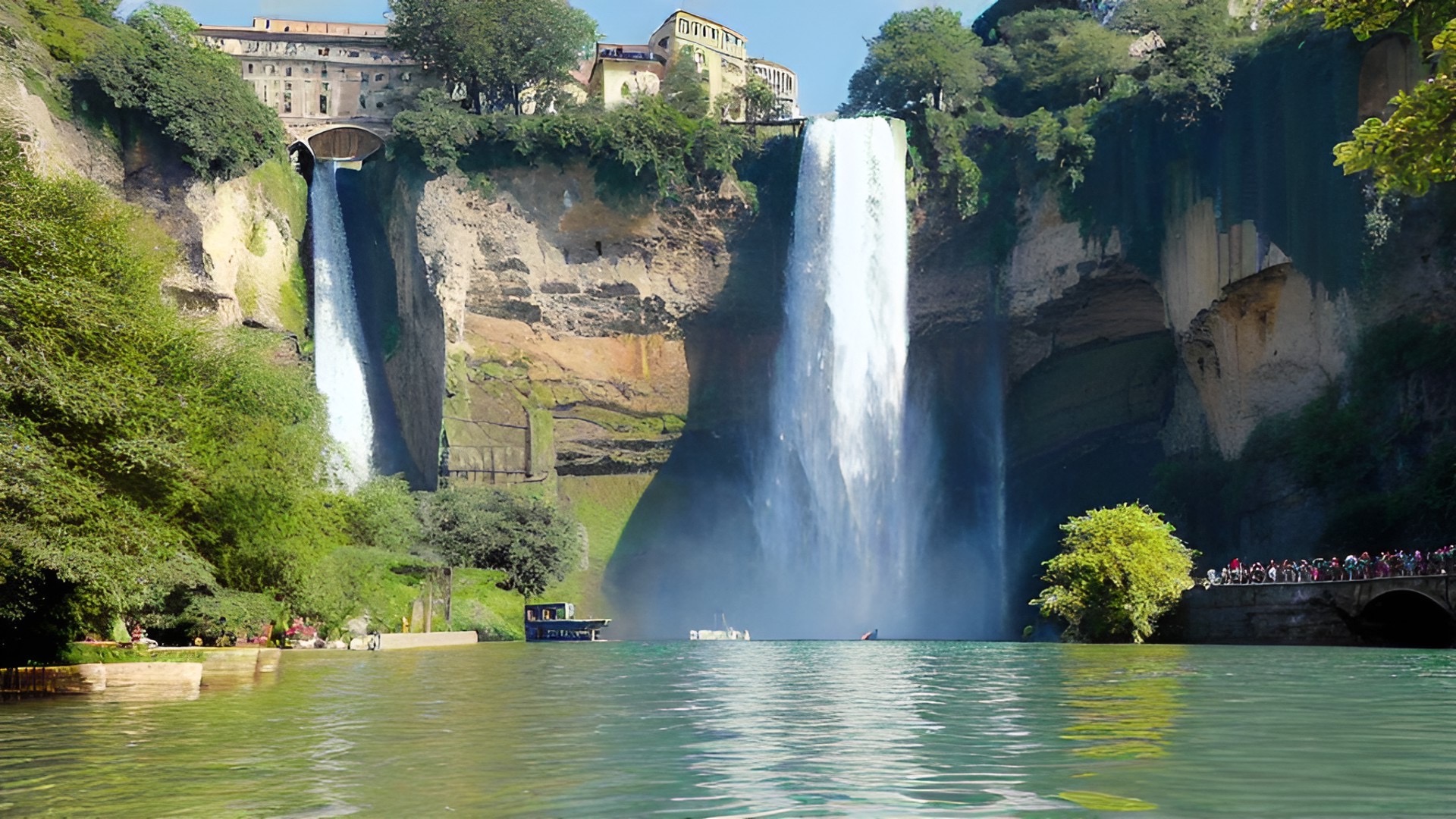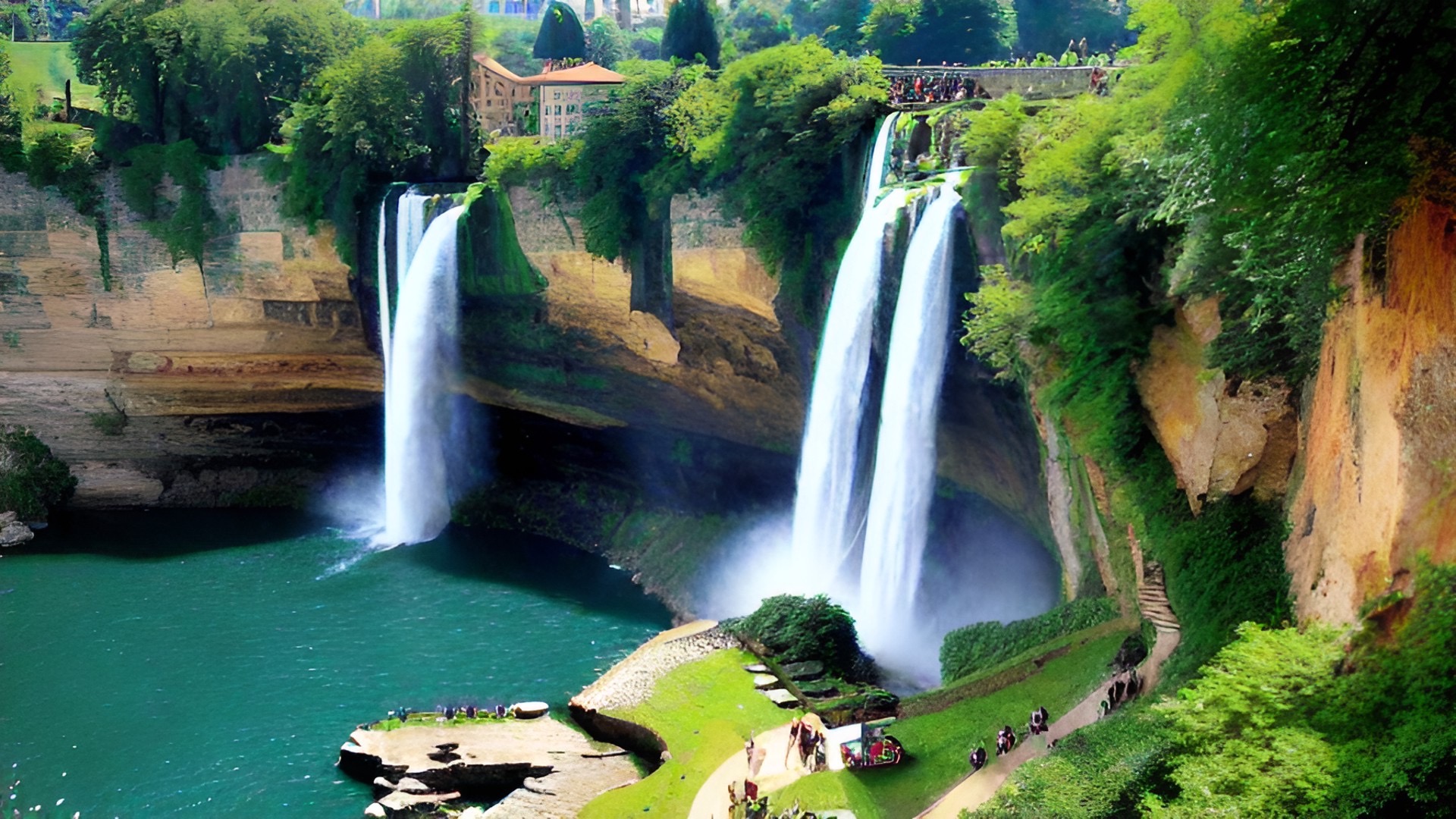Dwarfchat
Dwarfchat (altitude 2400’) is a town that the Dwarves use as a meeting point so as to keep outsiders out of the Dwarven undercities. It has a population of 6240 people. Population breakdown: 65% Dwarves; 18% Human, 5% Hobbit, 4% Goblin, 5% Orc, 3% Elf, <1% Aarakocra (mostly transient, but there are a few enclaves in the mountains, so a total of about two dozen live in town).
The roads to the undercities are guarded, with a series of security checkpoints to keep the tourists out. You have to have special permission to get into the undercities. It’s not too hard to get, but you still have to get permission. Otherwise, you don’t get in. But everyone is welcome in Dwarfchat.
Dwarfchat itself is in two parts: the main city lies above an escarpment, straddling a river that cascades down a waterfall to a small lake below. On the shores of that lake lies the other half of Dwarfchat. The main harbor is located in the lake, and most of the area is commercial/industrial, with a lot of warehouses, trading houses, and other services related to river trade. Dwarfchat is the main eastern embarkation point for the goods of the set of undercities that lie under the Zirinibar Mountains. A lot of trade flows through Dwarfchat, and it levies a small tax on everything, both in and out. So it’s relatively wealthy, and well maintained.
As it’s the “face” of the Dwarven undercities, the Dwarves make sure that it looks the part. There are no slums, no shanty towns, and no homeless. There are also no thieves’ guilds here. None. Citizen protection groups are unnecessary; the City Council has a police force with some rather authoritarian powers, called the Civil Patrol. Their Patrollers actually do keep the peace and fight crime, unlike many other towns and cities, where petty crimes and crimes against peasants are pretty much ignored. They also have a more traditional City Guard, but they are a much smaller group, and are more militaristic in both their function and demeanor. They are there to defend the city, not fight crime. As one travels through the city, several public stocks can be seen, on street corners, markets, and public parks. Several will have people in them, arrested for various violations.
There is no graffiti allowed, no littering, no vandalism. All of those things have some rather harsh punishments, ranging from fines to public stocks to public flogging. They take the aesthetic condition of the town very seriously. Law abiding citizens will often mock those in the stocks, and throw rotted fruit at them. Throwing of dung or other bodily wastes is considered littering, and punished appropriately. Throwing dangerous items, like stones or other hard objects, is considered assault. Just because someone is a minor criminal doesn’t mean you can do anything you want to them.
Most of the residential areas are in the high districts, although there are some inns and houses down below. While there are a few eateries for the wharf and warehouse workers to use, none of them are outstanding.
The construction of the buildings in Dwarfchat are primarily of stone, with slate tile roofs. They aren’t easy to walk on, especially if wet. And it’s on the wet side of the mountains, so it rains fairly often during the fall through early spring seasons. Fairly dry otherwise, though. The stone color is a brownish grey, the slate is a dark grey, turning nearly black when wet. Many buildings are three stories, with a preponderance of multi-family residential structures. This mirrors Dwarven living arrangements in the undercities. (Dwarven cities come in two basic forms: one is a “typical” city in a cave, the other is a “kiva”-like warren of interconnected tunnels. Non Dwarves have trouble finding their way around in those. It’s like a 3D maze of spaces and tunnels.)
Buildings, especially in Upper Dwarfchat, are built shoulder to shoulder, with no alley or space between them. So the blocks tend to be pretty monolithic, and with few nooks and crannies to get lost in. There are occasional doors that lead to what amounts to a hallway that besides giving access to the street on the other side of the block, but also some doors leading into the buildings on either side. So technically there are alleys, but they are “hidden” behind doors.
Lower Dwarfchat is less like that, mainly due to the fact that most of it is more commercial, and requires wagons and loads to be able to move around.
The main part of Dwarfchat straddles a pair of rivers that fall off a cliff, forming a pair of beautiful waterfalls 140’ tall before forming a lake, which is where Lower Dwarfchat is located. That is also where the wharves are for the riverboats that are used for trade and transportation to the eastern parts of the Empire. Dwarfchat acts as a trading clearinghouse for the undercities, for the trade headed eastward. The southern road leads to the Causeway Entrance near Barazinbar, which is 30 miles away as the crow flies. Overland, however, it’s closer to 80, as it winds up into the mountains, with lots of switchbacks. The western road leads to the Causeway Entrance near Nogrod, which is 80 miles as the crow flies. As it also winds its way through the mountains, the overland distance is 230 miles.
The trails are well-maintained, and there are traveler stations every ten or so miles, consisting of a small walled shelter, with cooking facilities (earthen oven, wood stove, counter space). The Dwarves have the Mountain Rangers (their version of the Rural Watch) that patrol the roads in the mountains; their mandate is to protect the travelers on the roads. They do not like brigands, and do what they can to limit their activities. They are less worried about wild animals; they don’t really do much about bears, cougars, etc., figuring that those hazards are taken into consideration by the travelers. If they come across people fighting off the wildlife, they will assist.
Typically, they are armed with partisans (shortswords on a stick, with a pair of “wings”), gambeson, and chainmail. Some have brigandine vests, if they can afford it. Sidearms are shortswords, and they will typically have a shield on a guige, usually kept on the back for passive defense, unless they have to drop the partisan. Helmets are usually sallet helms with a bevor. They are typically organized in teams of four, and have all trained together (Teamwork Perk, wMA52, and Shield Wall Training MA51). Typical formations are offset 2x2, and 3 in front, 1 in back.
Demographics
65% Dwarves; 18% Human, 5% Hobbit, 4% Goblin, 5% Orc, 3% Elf, <1% Aarakocra (mostly transient, but there are a few enclaves in the mountains, so a total of about two dozen live in town)
Government
Council Curia, under the local Baron
Defences
Downriver is the Locks, a fortified river locks structure. Nearby is a fortress, on a hill, called Githlîn Zirik'azg, that houses two centasentis of Tondene Imperial Army troops (about 200 soldiers). Being in the heartland of the Tondene Empire, they don't really have to worry about foreign enemies attacking. These troops are mainly for domestic problems such as bandits or aggressive wildlife.
Industry & Trade
Dwarfchat has the usual local industries: farming, smithing, baking, tailoring, etc. It's main industry is as a trading hub, acting as the gatekeeper for outside trade with the Dwarven Undercities beneath the Zirinibar Mountains. Any trade going into the Undercities goes through Dwarfchat first, and a tax is levied.
Infrastructure
Stone roads, The Lift, Sewers, Aqueducts, Bridges, Caravansarai
Districts
Upper Dwarfchat, comprised of the Lord's Keep, The Walled City, and Upper South Dwarfchat
Lower Dwarfchat, comprised of the Wharfs, the Warehouses, the Residences, and the Caravansarai
Lower Dwarfchat, comprised of the Wharfs, the Warehouses, the Residences, and the Caravansarai
Guilds and Factions
Civil Patrol
Power: 7 (usually only 5, but these are trying times)
Leader: Arben Thunderstone
Trading Guild
Power: 8
Leader: Harcan Underpeak
Caravaner’s Guild
Power: 4
Leader: Joren Hammerstrike
Notes: innkeepers and bartenders at caravansarai are members of this guild. So it’s possible that those staying in the caravansarai will overhear some comments about the political infighting between the Caravaner’s Guild and the Trading Guild, and how the Trader’s Guild keeps upping the dues, and not addressing the problems that the caravans and their support industries have to deal with. They are also upset that there is a higher tax, recently levied, on caravaners. The guild is worried that the higher tax will discourage caravans.
Mason’s/Builder’s Guild
Power: 5
Leader: Monash Rockycrag
Notes: There are three new houses under construction (two in Upper Dwarfchat, one in Lower), a warehouse is getting a new roof, a shrine is being built in Upper Dwarfchat, and a general store (Lower Dwarfchat) was damaged in a manticore attack. Played will see the construction sites if they wander around town.
City Council
Power: 6
Leader: Konarr Stonebeard
Mountain Rangers
Power: 4
Leader: Palen Snowpeak
Baker’s Guild
Power: 6
Leader: Theobold Tripeak
Notes: The Baker’s Guild is the most important of the foodstuff guilds (the other ones being the butcher’s guild, beekeeper’s guild, brewer’s guild, and the cheesemaker’s guild, and peripherally, the grower’s guild. Bread is life, even breads made with mushrooms and other fungi.
Chandler’s Guild
Power: 3
Leader: Willibert Whitemount
Tailor’s Guild
Power: 4
Leader: Dwalin Baldurson
Grower’s Guild (farmers, both above and below ground)
Power: 5
Leader: Edmont Alpinefield
Notes: the Dwarfchat City Council is made up of the local nobility, the heads of the guilds, some prominent merchants, and a few others who’ve managed to get on the council somehow. It’s run similar to a parliament, where small groups gain power by mutual support and temporary alliances.
Tondene Imperial Army
Power: 2
Leader: Bronten Weaverson (Human)
Notes: Located at Githlîn Zirik’azg, it is a small garrison of 200 or so soldiers (2 centisentis, Maroon and Aqua). They have been alerted to the Manticore, and have small patrols out in the forest looking for its lair (6 groups of 10 soldiers each, armed with the standard weapons and armor, and each has two mules to carry the tents and group gear).
Smithing Guild
Power: 6
Leader: Dargo Mastersmith
Other guilds:
Beekeepers (2)
Butchers (3)
Ranchers (3)
Hatters (subsect of the tailors, actually)
Brewers (4)
Healers (4)
Colorers (dyes, paints, pigments) (2)
Renderers (Subsect of the butchers)
Cobblers (2)
Leatherworkers/Tanners (2)
Scriveners (3)
Cheesemakers (2)
Mage Guilds
(4; Delver’s Guild (elemental, making/breaking), ATT (knowledge, comms), 2 “General purpose” guilds) Delver’s Guild (Elemental, Making/Breaking) (enchanting) Power: 5 Leader: Fargin Saltfist Artem, Tennant, & Tricola (ATT) (Comm/Know) Power: 2, down from 4 Leader: Kelven Squireson Blue Sapphire (General, most colleges: broad, but shallow) Power: 5 Leader: Iron Mountain (General, most colleges: broad, but shallow) (some minor enchantment) Power: 3 Leader: The two general guilds have different mixes of spellsOther guilds:
Beekeepers (2)
Butchers (3)
Ranchers (3)
Hatters (subsect of the tailors, actually)
Brewers (4)
Healers (4)
Colorers (dyes, paints, pigments) (2)
Renderers (Subsect of the butchers)
Cobblers (2)
Leatherworkers/Tanners (2)
Scriveners (3)
Cheesemakers (2)
Points of interest
The waterfalls
The Lift
Mountainstream Inn
The Wharves
The Lift
Mountainstream Inn
The Wharves
Tourism
Mostly traders, merchants, caravans.
Architecture
Mostly stone, with buildings built close together if not shoulder to shoulder with no alleys between them.
Geography
Mountainous and wooded, with tilled fields. The city itself straddles two rivers and a lake.
Climate
Temperate
Natural Resources
Wood, mineral ores, forest products
Population
6240
Inhabitant Demonym
Chatters
Location under
Characters in Location
Related Reports (Primary)
Related Reports (Secondary)





Comments